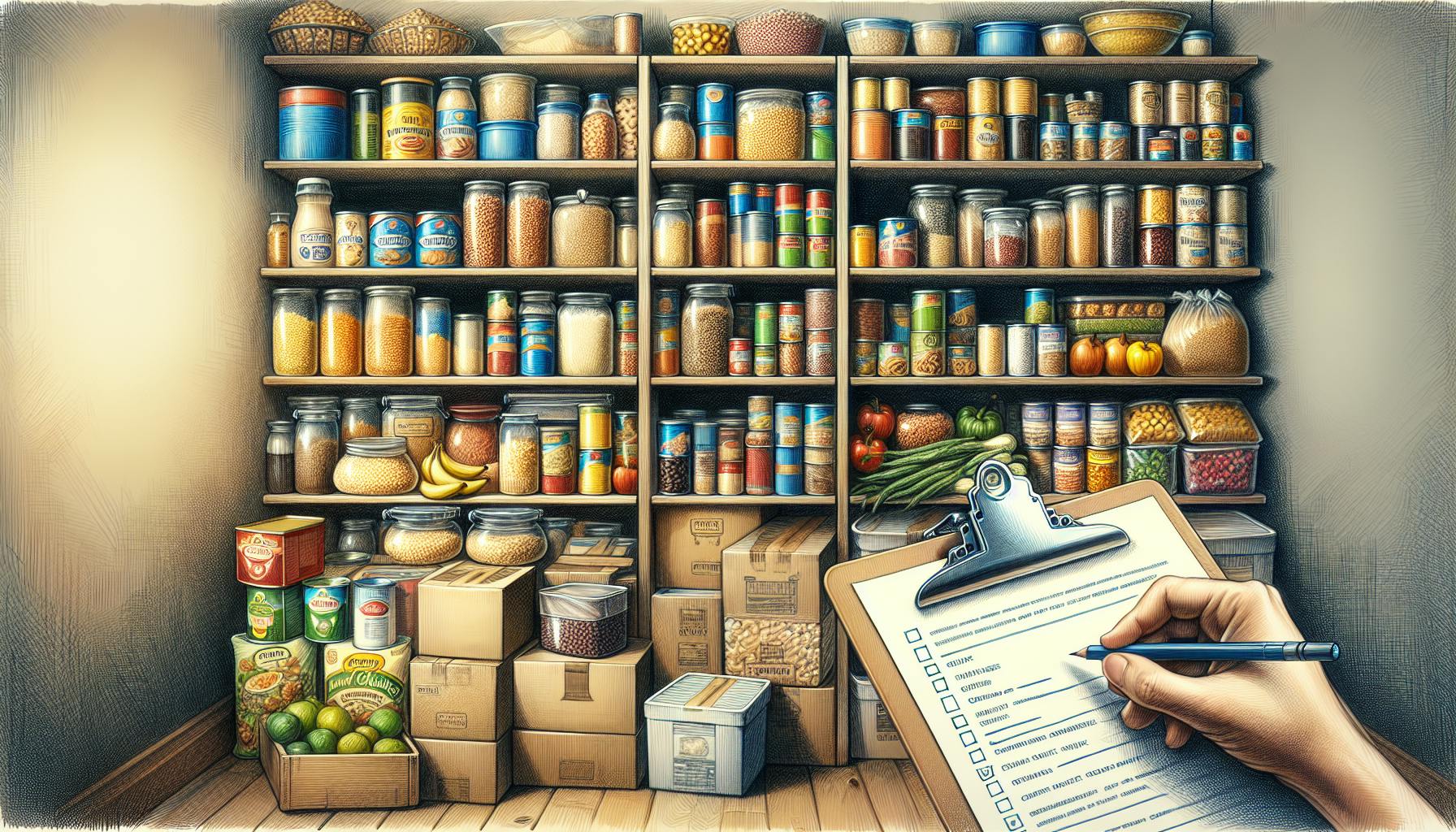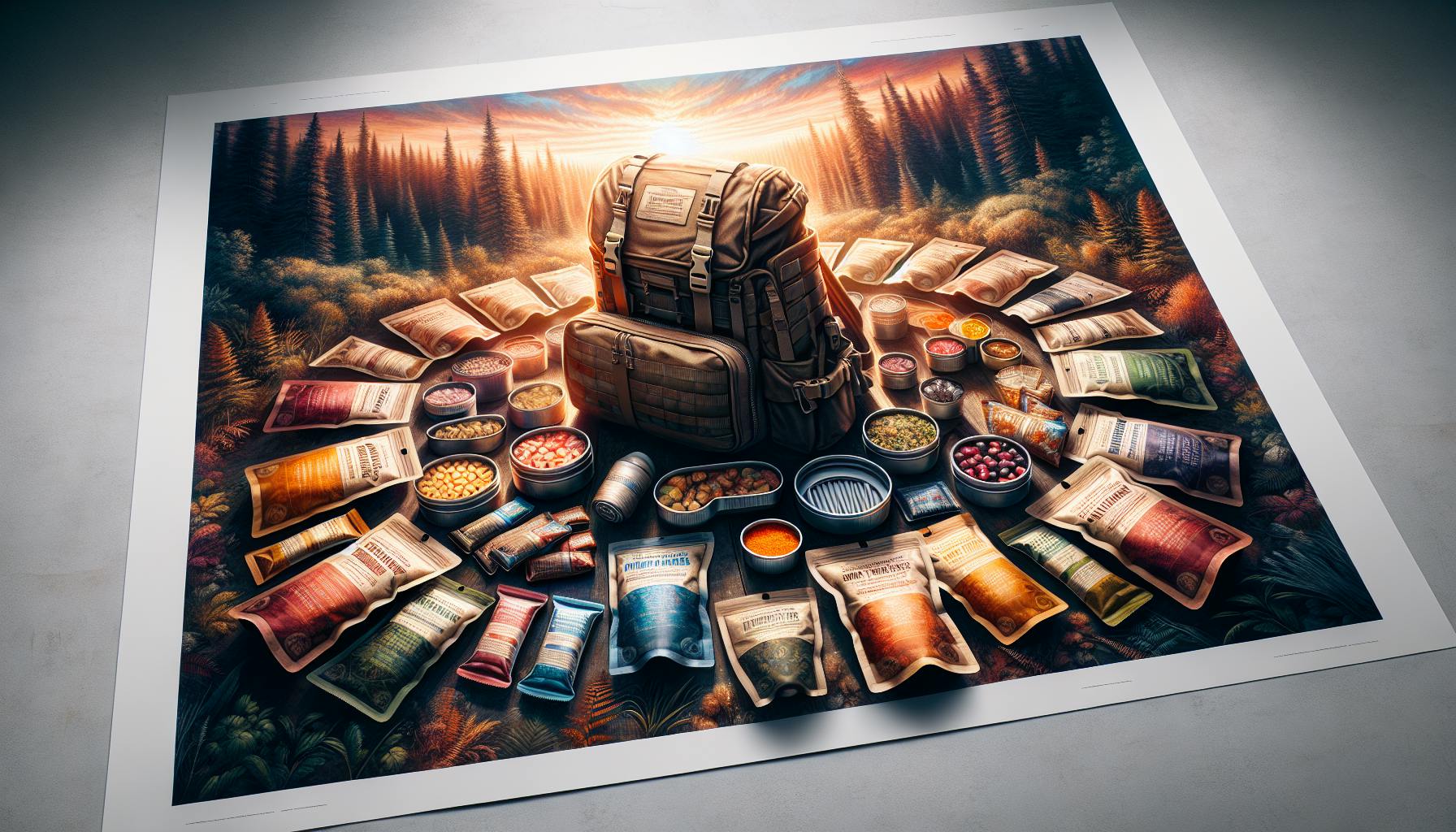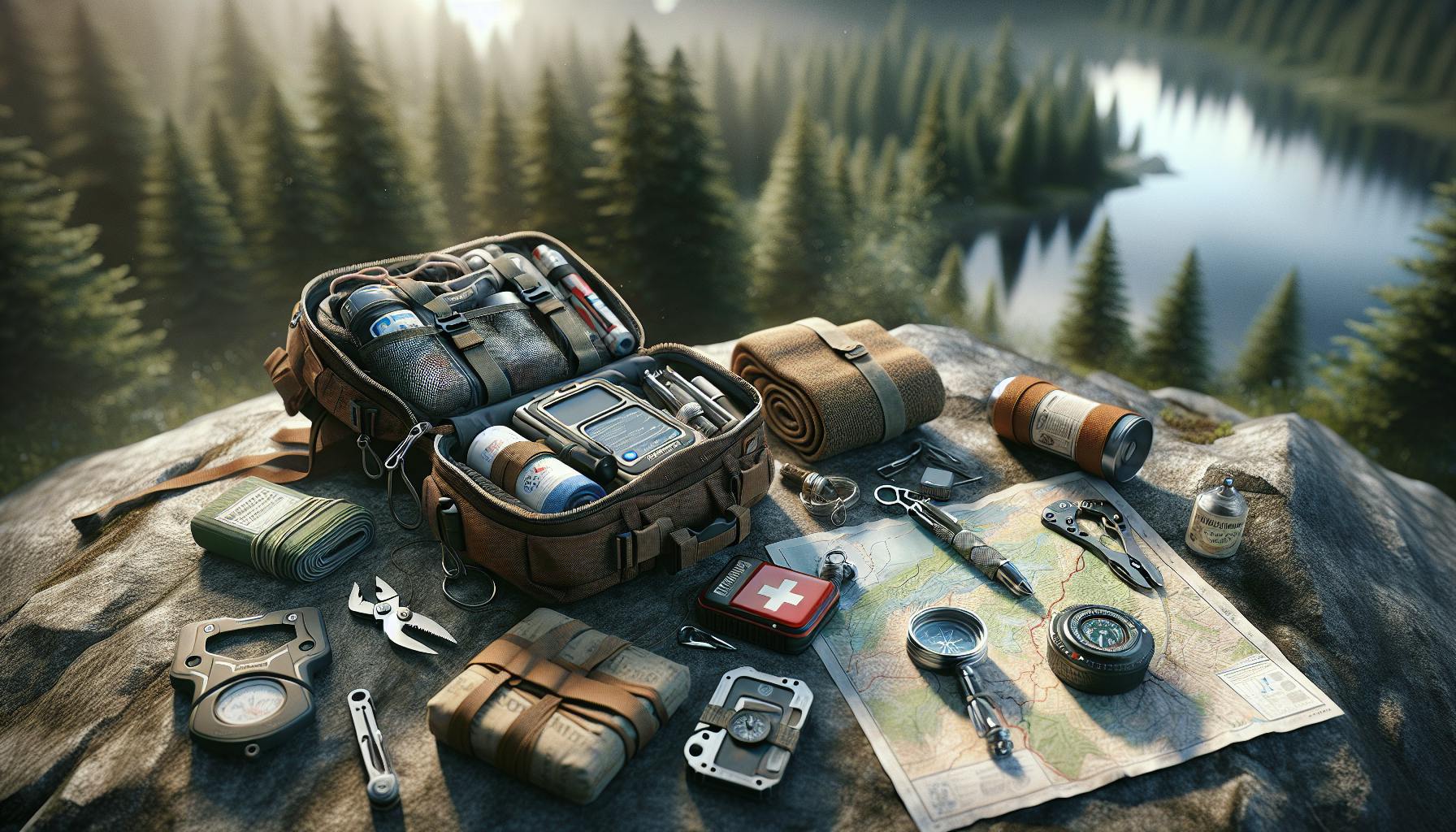Finding efficient and reliable survival food is crucial, yet most preppers struggle to determine the top options.
In this roundup, we cut through the noise to highlight the best survival food kits that offer practical, nutritious, and long-lasting emergency rations.
You'll discover the ideal food packs for every budget and dietary need, learning exactly what to look for when stocking up on supplies that could save your life.
The Importance of Top Rated Survival Food Kits for Efficient Prepping
Survival food kits play a critical role in emergency preparedness by providing essential nutrition when access to food is limited. Assembling an efficient survival kit requires carefully considering key criteria like practicality, nutritional balance, taste preferences, and shelf life.
Understanding the Role of Survival Food Kits in Emergency Preparedness
A survival food kit contains calorie-dense foods designed to keep you nourished in disaster scenarios. Kits come fully stocked with items like freeze-dried fruits and vegetables, canned goods, powdered milk, high-calorie ration bars, and more. The key benefit of survival food kits is consolidating all your emergency food essentials into one easily accessible, transportable container. Whether hunkering down at home during a weather disaster or bugging out to a secure location, having reliable access to food and nutrition bolsters resilience.
When selecting a survival food kit, it is crucial to assess your household's unique needs in terms of calories required, dietary restrictions, food preferences, and intended duration of use. With the right food kit, you can sustain energy levels and health to persevere through power outages, supply chain disruptions and other emergencies.
Criteria for Efficient Prepping: Practicality, Nutrition, Taste, and Shelf Life
An efficient survival kit optimizes for key criteria:
Practicality: Choose portable kits in durable containers, with items requiring minimal prep and water. Optimal kits have 25+ year shelf lives, saving the need to continually restock.
Nutrition: Seek variety in macro and micronutrients - carbs, protein, healthy fats, vitamins and minerals. Kits with 2,000+ calories per day help avoid malnutrition.
Taste: Many kits now offer tasty options like chili, stroganoff and apple crisp. This ensures you stick to the rations. Seek additional seasonings to improve flavor.
Shelf Life: Look for kits with 5+ year expiration dates stored in protective packaging. The longer the shelf life, the better.
By evaluating survival food kits against these criteria, you enable efficient prepping tailored to your household's nutritional needs, tastes, practical constraints and duration requirements.
What is the best survival food to buy?
When building an emergency food supply, it's important to have nutrient-dense foods with a long shelf-life that don't require refrigeration. Some top-rated options to consider stocking up on include:
Canned and pouched foods
Canned foods like vegetables, fruits, meats, and seafood are convenient, affordable sources of essential nutrients. Canned tuna, salmon, chicken, and other proteins provide protein. Canned veggies like carrots, green beans, and peas offer fiber, vitamins, and minerals.
Dried and freeze-dried foods
Dried fruits like apricots and raisins are tasty sources of nutrients. Freeze-dried meats like ground beef can be prepared into meals when needed. These foods last for years and rehydrate quickly with water.
Nut butters and nuts
High-calorie foods like peanut butter and nuts are rich in protein and healthy fats. Nut butters are a satisfying addition to crackers, bread, or eaten alone. Trail mixes with nuts, seeds, and dried fruit make convenient grab-and-go options.
Whole grains
Whole grain crackers, cereal, granola bars, and power bars provide lasting energy. Pair with nut butters for added nutrition. Look for whole grains as the first ingredient for maximum nutrients and fiber.
When building your emergency food supply, focus on nutrient diversity to support health. Stock up on foods your family already eats for convenience. Prioritize canned/pouched veggies, fruits, proteins, nut butters, nuts, seeds, and whole grain options. Rotate and replace food as needed to keep it fresh.
What survival food has the longest shelf life?
Freeze-dried meat has the longest shelf life of any survival food, with a shelf life of over 25 years. This exceptionally long shelf life makes freeze-dried meat an essential component for an emergency food stockpile.
Here's why freeze-dried meat is the ultimate long-term survival food:
- Extremely Long Shelf Life: With a shelf life of 25+ years when stored properly, freeze-dried meat far outlasts any other type of survival food. You can stock up and forget about expiration dates.
- Lightweight and Portable: Freeze-dried meat is extremely lightweight and compact compared to canned goods. It's easy to store and transport as part of your go-bag or emergency kit.
- Convenient Preparation: You just need hot water to rehydrate freeze-dried meat into a nutritious meal. No cooking or refrigeration is required.
- Nutrition: Freeze-dried meat retains most of the protein, nutrients, and flavor of fresh meat, even after decades of storage. It provides essential nutrition in an emergency situation.
With its unmatched shelf stability, freeze-dried meat is quite simply the best way to store meat for emergency preparedness. Every survival food supply should contain hearty helpings of freeze-dried meat as the long-lasting protein source.
Is it worth buying emergency food?
Emergency food kits can provide critical sustenance in disaster situations when access to food is limited. Investing in a high-quality survival food supply has many benefits for preppers:
Long Shelf Life
The best emergency food kits are designed for long term storage, with some foods lasting up to 25 years. This ensures the food remains edible and nutritious when you need it most. Popular options like freeze-dried and dehydrated foods have an impressively long shelf life.
Nutrition
Many kits are packed with calorie-dense foods to provide energy. They also aim to supply a balance of carbs, protein, vitamins and minerals. This complete nutrition helps maintain health in stressful scenarios.
Portability
Survival food kits come in portable containers that are easy to store and transport if evacuation is necessary. Lightweight pouches and compact buckets keep portions controlled and space-saving.
Affordability
Building a stockpile of survival food may seem costly upfront, but is very affordable compared to accumulating single ingredients over time. Kits allow bulk-buying of essentials at a discounted per-meal price.
When an emergency strikes, having survival food on hand provides comfort and sustenance. Kits with durable packaging, long shelf lives, balanced nutrition and portability deliver reliable, efficient access to critical supplies when you need them most.
sbb-itb-b932644
Does survival food really last 25 years?
Many premium survival food kits contain meals that are designed to last for decades when stored properly. This extended shelf life is achieved through food preservation techniques like freeze-drying and dehydration.
How freeze-drying extends shelf life
Freeze-drying removes up to 98% of the water content from foods while retaining most nutrients. This creates a very low-moisture environment that prevents bacterial growth and slows down chemical reactions that lead to spoilage. As long as the freeze-dried pouches remain sealed and stored in a cool, dark place, the food inside can last 25 years or more.
Popular freeze-dried ingredients in survival kits include:
- Fruits like strawberries, blueberries, and bananas
- Vegetables like corn, peas, carrots, and broccoli
- Dairy products like cheese and milk powder
- Meats like chicken, beef, and turkey
How dehydration preserves foods
Dehydration draws moisture out of foods using low-heat drying methods. Like freeze-drying, this creates an unfavorable environment for spoilage organisms to grow. Dehydrated ingredients are very shelf-stable but can have slightly shorter lifespans than freeze-dried items.
Some commonly dehydrated survival foods are:
- Pasta, rice, beans, grains
- Herbs and spices
- Soup mixes
- Vegetables like onions and potatoes
So in short - yes, with the right processing and storage methods, survival food can retain its safety and nutritional value for decades. This makes it a smart choice for emergency preparedness and long-term food storage.
Best Survival Food Kits of 2023: Comprehensive Reviews
When preparing for emergencies, having reliable survival food kits stocked ensures you and your family are ready for any situation. As climate change leads to more extreme weather events and global instability rises, having an emergency food supply becomes increasingly prudent. In this section, we review some of the highest rated survival food kits available in 2023.
ReadyWise Emergency Food Supply: A Family's Reliable Choice
For those looking to prepare their household, ReadyWise offers comprehensive emergency food kits to meet a family's needs. Their 25-year emergency food supply contains over 20,000 servings, providing long-term sustenance across a variety of food groups. With a shelf life of 25 years, it offers reliable nutrition for years to come. The kits also include water pouches and filtration equipment like the Lifestraw Family water filter. ReadyWise ensures balanced nutrition across essential macro and micronutrients. With gluten-free and vegetarian options, it caters to diverse dietary needs. Their food tastes better than most survival food thanks to sodium caseinate for improved texture and flavor. ReadyWise lets families prepare for any situation with confidence.
Survive2Thrive Vegetarian Preparedness Pail: Plant-Based Nutrition
For vegetarians and vegans seeking emergency preparedness, the Survive2Thrive pail offers 100% plant-based ingredients. With 60 servings providing over 2,000 calories, it contains a balanced nutritional profile across organic ingredients like quinoa, lentils, chickpeas and more. As a low glycemic, non-GMO and soy-free supply, it provides sustainable nutrition for emergencies. With a 10-year shelf life and no refrigeration required, Survive2Thrive lets vegetarians meet their household’s needs while maintaining diet integrity. It offers tasty flavors like southwest bean and rice soup alongside staples like rolled oats and apple cinnamon cereal. For those seeking a vegetarian-focused emergency food supply, Survive2Thrive delivers reliable, balanced nutrition.
Mountain House Essential Bucket: Best Tasting Survival Food Kits
For great taste alongside emergency preparedness, Mountain House kits prove a popular choice. Their Essential Bucket provides a 3-day supply with meals like beef stew, chicken teriyaki and more. With over 20 servings and a 30-year shelf life, it offers reliable nutrition for years, making it a wise long-term investment. All Mountain House meals are freeze dried to retain maximum nutrients and flavor. Their process enhances taste by lowering moisture content to concentrate natural flavors. Mountain House also provides balanced macro and micronutrient profiles, ensuring meals deliver complete nutrition. For those prioritizing taste alongside emergency readiness, Mountain House makes for an appetizing survival food kit pick.
Essential Components of a Survival Food Kit
When selecting a survival food kit, keep these key features in mind as you compare options for your emergency supply kit:
Nutritional Content and Caloric Density
Prioritize kits with a nutritional balance of proteins, fruits, vegetables, grains, and a sufficient caloric intake for survival situations. Look for kits that provide 2000-2500 calories per day to maintain energy levels in an emergency. Many top rated survival food kits like Augason Farms Emergency Food Supply offer nutritionally balanced meals with sufficient calories.
Consider storing additional nuts, protein bars, and dried fruits to supplement daily nutrition. Having a diverse backstock of single ingredients allows you to customize meals and meet dietary needs.
Taste and Variety: Ensuring Palatable Meals
Consider flavor and quality - many kits now offer tasty meals without compromising shelf life, making them the best tasting survival food kits. For example, brands like Mountain House use a freeze-drying process that preserves the taste and texture of ingredients.
Look for kits with a variety of cuisines to avoid taste fatigue. Many kits offer breakfast, lunch, and dinner options as well as sweet and savory snacks. Some even have gluten-free and vegetarian meal choices.
Long-Term Storage: The 25-Year Emergency Food Supply
Look for multi-year expiration dates, ensuring value for money invested and reducing the need for frequent rotation of your emergency food stock. Some kits like Wise Food Storage Emergency Food Supply offer a 25-year shelf life.
Consider portion sizes too - some kits provide a 60-serving option suitable for an individual while others cater to a family of 4. Calculating necessary quantities allows efficient stocking up.
Special Dietary Requirements: Gluten-Free and Vegetarian Options
Ensure that your kit caters to any specific dietary restrictions, such as gluten intolerance or vegetarianism, for a balanced and inclusive emergency plan. Many top brands now offer specialty kits like Legacy Premium's Gluten-Free Emergency Food Kit or Augason Farms Vegetarian Emergency Food Supply Kit to accommodate various needs and preferences.
Having an assortment of single ingredient backstocks also allows assembling customized meals. Dried beans, rice, oats, and quinoa provide excellent vegetarian protein and nutrients.
Practical Considerations for Storing Your Emergency Food Supply
Proper storage is key to preserving the quality and shelf life of your survival food kit, especially for a family. Here are some tips:
Choosing the Right Location for Your Food Supply
When choosing where to store your emergency food supply, opt for a dry, temperature-controlled area out of direct sunlight. Avoid places with pest problems or high moisture that could compromise the integrity of the food. Some ideal storage spots are a basement, closet, or dry pantry.
Using Appropriate Containers to Prolong Shelf Life
Storing your food supply in food-grade plastic buckets with tight lids or thick Mylar bags with oxygen absorbers can protect the contents from air, moisture, insects and extend shelf life. Make sure to label containers with contents and expiration date.
Organization Strategies for Quick Access During Emergencies
Categorize foods by type (fruits, vegetables, grains etc.) and label containers clearly for fast identification. Store foods you will use first closest to the top. Having an inventory list can also help locate items quickly in urgent situations.
Maintaining a Backstock of Single Ingredients for Versatility
In addition to full meal kits, keep a supply of single freeze-dried ingredients like meats and vegetables. These offer more versatility for cooking if faced with prolonged disaster situations. Prioritize nutrient-dense foods.
Conclusion: Securing Your Future with the Best Emergency Food Kits
By selecting one of the top-rated survival food kits highlighted and storing it properly, you can achieve efficient preparedness. Here are some key takeaways:
- Evaluate your nutritional needs, taste preferences, budget, and desired shelf life when choosing the best solution for your situation. Prioritize kits with longer shelf lives, budget-friendly pricing, quality ingredients, and positive reviews.
- Properly store your emergency food kit in a cool, dark, and dry location to maximize shelf life. Consider temperature-controlled storage to prevent spoilage.
- Incorporate emergency food kits into a larger preparedness plan including water storage, first aid supplies, shelter plans, communication devices, and more.
- Test and rotate your food supply to keep it fresh. Consume older products first and replace them with new ones.
- Choose kits with easy-to-prepare meals requiring only the addition of water in most disaster scenarios. This allows for quick, nutritious meals when needed most.
- Select vegetarian, gluten-free, or allergen-friendly kits if required to meet your household's dietary needs. Many kits now cater to specialized diets.
By making an emergency food kit part of your preparedness strategy, you can have confidence that your family will remain nourished in the aftermath of any disaster. Follow expert guidance to find the best solution for your situation.


